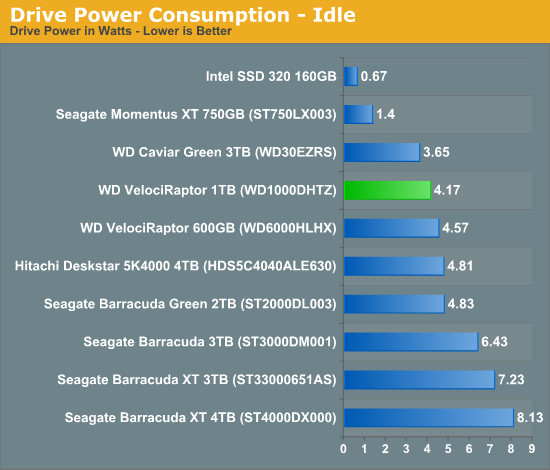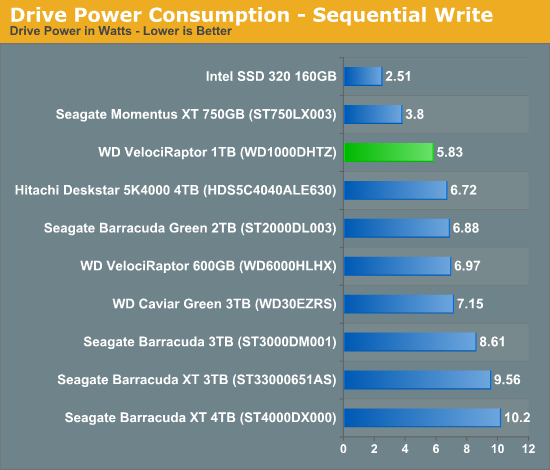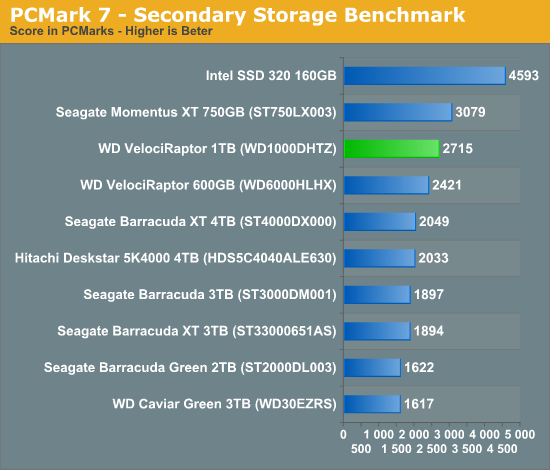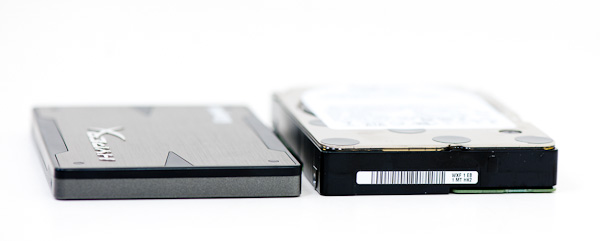Western Digital VelociRaptor 1TB (WD1000DHTZ) Review
by Anand Lal Shimpi on April 16, 2012 8:00 AM EST- Posted in
- Storage
- HDDs
- Western Digital
- VelociRaptor
PCMark 7 Performance
For workloads that are particularly read intensive and small enough to make good use of the on-board NAND, the Momentus XT cannot be beat. The VelociRaptor does come very close however, and it does win in enough other benchmarks to make it clearly the better overall performer. Philosophically I understand why Western Digital opted against equipping the VR with any NAND (cached operations do sort of defeat the purpose of having a 10,000 RPM spindle speed), but that doesn't change the fact that it would've made for one pretty impressive hard drive.
Power Consumption
Despite its 2.5" form factor (the drive itself), the VelociRaptor's 15mm height prevented it from being used as a notebook drive. Even if you had a thick enough notebook, the VR's power consumption is more in-line with a 5400RPM 3.5" drive than a standard 2.5" mobile drive. That being said, as a 10,000RPM 3.5" drive the VelociRaptor is quite power efficient. Idle power is competitive with WD's Caviar Green (and lower in the case of load power).
Power consumption is down compared to the previous generation as well. Once again, compared to an SSD however the drive isn't anywhere near efficient.














92 Comments
View All Comments
c4v3man - Monday, April 16, 2012 - link
Exactly. Dell offers these drives in their workstation lineup, and I think at one point offered them in their 100-300 series servers. It would be great if Anand would compare the drive to a modern 10K SAS drive, to see how close the two technologies are nowadays.That being said, 600GB 15K SAS drives are under $500 I believe from Dell, so it would only make sense as mass storage.
dananski - Monday, April 16, 2012 - link
I think you're on to something there - SAS drives are getting expensive enough that you start to think about SSDs, so maybe these would fill that big price gap between standard and enterprise drives.Would be pretty good for some other situations too. Games, video editing, music production and image editing need space and sequential speed and this gives both those things at a lower budget than an SSD.
shin0bi272 - Monday, April 16, 2012 - link
What surprised me about this is that they didnt try pushing it to 15k rpm. Some nand would have helped too but as you said in the opening paragraphs... about the only way you can increase speed in a spindle disk is to increase rotational speed or area density. So why not do both? Not sure if they use perpendicular recording on these or not but that would be another way to increase the density and the speed.Of course the down side is that not only is nand still MUCH faster and getting cheaper by the day but, we also have PCM drives coming (hopefully) soon which is 100x faster than flash and lasts for millions of write cycles rather than thousands... Unless its $1000 per gig for the next 10 years who's going to buy a spinning disk when its 10,000X slower than a pcm drive?
Stahn Aileron - Monday, April 16, 2012 - link
Last I recall, bumping up the spindle speed would counteract the areal density increase. Every time I see a spindle speed bump across drives in a similar price bracket, the capacity goes down. I'm guessing it has to do with how quickly the heads can actually read the data under them before its move out from under them. (Perhaps ECC as well.)Still, the last time I saw a 15k RPM drive, the max capacity I think was around 320GB or so. I can't say for certain now as I don't track 15k RPM drives. I don't have the need for enterprise-grade HDDs of that performance. (And to be honest, most storage coverage these days is about SSDs. HDDs don't get into the news much except for the ocassional model revision, if that.)
piroroadkill - Monday, April 16, 2012 - link
I have some 600GB 15K SAS drives right here.Stahn Aileron - Monday, April 16, 2012 - link
Well, like I said, it;s been a while since I bother to look at 15k drives, even in passing, much less recall the numbers. On the other hand, 15k 600GB SAS drives do sound/look familiar. Still, that's the upper end of the capacity spectrum for 15k drives right now, no?shin0bi272 - Tuesday, April 17, 2012 - link
actually I feel you on the not paying attention to 15k drives. That's kinda why I was hoping WD was going to push their Vraptors faster and maybe keep the size around 300-500gb... They are usually so expensive that individuals arent even aware they exist. WD could have changed that but they didnt. They could have made huge changes to the slowly dying spinning disk market... but they didnt. They just increased the size of their current 10krpm drive.Dont get me wrong a 10krpm 1tb drive is cool (especially for the price) but no one needs this drive in their home. A gamer will have an SSD and a plain old drive for storage to keep their files on. A graphic designer might do the same. And people who dont need the performance of an SSD (like lets say my dad) just throw in a 7200rpm drive and call it close.
But yeah no one does reviews of spinning disk anymore because they are becoming obsolete pretty quickly with the falling costs of SSDs (even in the enterprise market) and like I said originally PCM drives.
shin0bi272 - Tuesday, April 17, 2012 - link
http://gizmodo.com/5808353/solid-state-drives-are-...Arnulf - Monday, April 16, 2012 - link
"... the only 3.5" hard drive with a 10,000 RPM spindle speed ..."There have been many real 3.5" drives with 10K (and higher) spindle speed before WD's (Veloci)raptors. It wasn't WD who changed anything, they merely copied what other manufacturers have done years before them.
While others manufacturers went to 15K for performance drives WD is still stuck in 1990s with everything but recording density.
Stahn Aileron - Monday, April 16, 2012 - link
I think Anand means at the consumer level. All 10k and 15k drive other than the VR from WD are aimed solely at enterprise. They are engineered/marketed as such from what little exposure I have of that market space. In all the time I've been into computer news (about a decade), the WD Raptor and VelociRaptor line were/are the only consumer-level 10k RPM drives. All other high performance drives in the consumer space have been 7200RPM drives. I don't ever recall seeing another 10k or 15k drive from any other manufacturer aimed at the consumer space (even if just at the enthusiast level.)